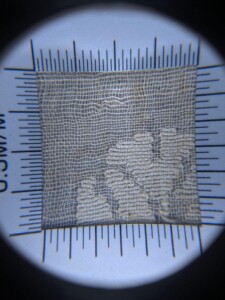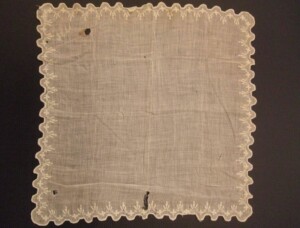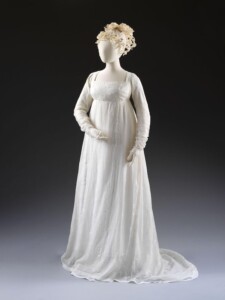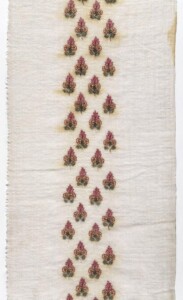Definition
Name Variants
With Qualifiers
muslin [Preferred Spelling, English], mousseline [Dutch], mousseline [French]Textiles, Modifiers, and Values
Choose a textile from the dropdown list on the upper left. Select modifier(s) for your selected textile, if any. The bar graph will generate visualizations that reflect your selections. X- and y-axis variables can also be changed.
A note about modifiers: The modifier dropdown list will include only those modifiers that relate to the selected textile. Choose OR to see results that match any of the selected modifiers. Choose AND to see results that match all of the selected modifiers. You can select more than one modifier in each field.
Essay
The term ‘muslin’ was not used in the seventeenth- and eighteenth-century documents that are the sources for the project, instead a variety of cloths which early modern European consumers, as well as us today, would categorize as muslins were referred to by names that indicated different origins, qualities, and varying local naming conventions. In this project’s data, the following terms are all types of muslins: adathaies, alliballies, bethilles, caffa, camcanys, dimity, douriasten, guldars, hammans, jamdanies, mallemolens, sanen, tanjeebs, and therindains (in alphabetical order). Other types of muslin known to Europeans that don’t appear in this data include: cummuns, dosooties, humhums, khasas, nainsooks, rehings, sallowes, seerbands, seerbettees, seerhaudconnaes, serribaffs, shalbadts, shash—either the Dutch did not trade these types or they used different terminology. There are spelling variations for each of these, as these non-European terms were transliterated—these spellings were the more common Dutch versions of these terms. These muslins for the most part are described in the dataset as having various grades, ranging from superfine to coarse or heavy, but if no weight is indicated, the case may be that this type or term always referenced the same weight, and thus the clerk had no need to note it specially. Often, the cargo is described by its geographic origin, primarily Bengal or Coromandel Coast, sometimes with a specific port within those regions. Seldom is a color provided, many are white cloths, and where a pattern is indicated, all are floral. Again, if a specific type always has the same pattern (for instance striped), the clerk would not have cause to note that. The term bethilles has a wide range of modifiers in the dataset, and it is also traded in the largest quantities by far.


Historical and contemporary glossaries define these as mostly white, lightweight, cotton cloths. A few exceptions: bethilles dasjes, douriasten, jamdanies, and tanjeebs had silk or mixed cotton and silk varieties (see example of silk muslin handkerchief in the gallery below); dimity, douriasten, and jamdanies could be patterned, jamdanies specifically with additional threads woven in (see example at right). Most of the textiles falling under the umbrella of muslins are catalogued in collections today only by the term ‘muslin,’ so it is difficult to connect the individual terms to specific samples. However, examples of muslin abound, like this handkerchief, embroidered with the date 1738, likely of Madras muslin. The dark background in the photo demonstrates how semi-transparent the fine-woven cloth is. The embroidery is a second stage of finishing this square of cloth into a usable object; unlike the jamdani example, the embroidered threads pierce the base cloth in multiple directions, showing they were not incorporated during weaving.
These muslins all originate in the Indian subcontinent, most types from Bengal, bethilles primarily from the Coromandel Coast, and a few shipped from Sri Lanka. The exceptions are dimity and guldars, which in the current dataset only ship from the Dutch Republic, and in very small numbers. Specific quantities and geographical distributions patterns are best seen by searching each type in the app, and eventually each of these textiles will have their own entry in the Visual Textile Glossary.


Muslin was much in demand across Asia and Europe. Lightweight Indian cottons, perhaps muslins, were known and celebrated in antiquity in Greece and Egypt, as we know from textual references. In the late eighteenth and nineteenth centuries, fine while muslin was the height of fashion for European Neoclassical women’s wear, popularized by Josephine Bonaparte. Muslin was also an important textile in dress across the Middle East and the Indian subcontinent, where it was a desirable cloth for wrapped turbans, sashes, and outer garments. Because of its semi-transparent weight, muslin can be differentiated in visual culture when it reveals the body or other garments beneath it, a challenging texture for artists to represent.
MK






